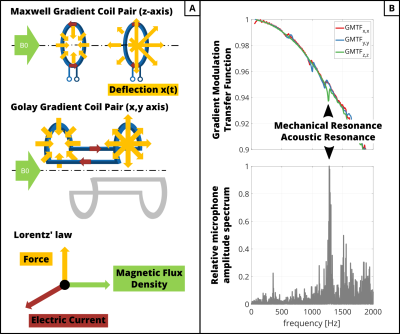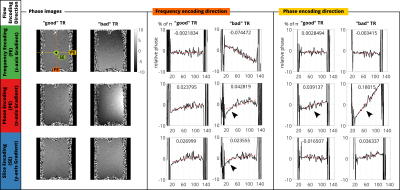Hannes Dillinger1, Eva Peper1, Christian Guenthner1, and Sebastian Kozerke1
1Institute for Biomedical Engineering, University and ETH Zurich, Zurich, Switzerland
1Institute for Biomedical Engineering, University and ETH Zurich, Zurich, Switzerland
Using mobile phone audio recordings, we were able to identify mechanical resonances and beneficial TR,TE-combinations for background phase error reduction in phase-contrast MRI. Mechanical resonances are shown to be the source of increased linear and quadratic background phase offsets.

Figure 1: (A) Rapidly switching electric currents in the gradient coils cause mechanical deflection according to Lorentz’ law. The deflection causes the magnetic field gradient to oscillate with mechanical resonance frequencies. These can be identified (B) using either the Gradient Modulation Transfer Function (GMTF) or the Relative Microphone Amplitude Spectrum (RAMS). Of note, the RAMS during scanning can be acquired without special equipment (audio recording with mobile phone).

Figure 4: Comparison of TR=5ms (‘good’) and TR=4.69ms (‘bad’) for TE=2.35ms and $$$f_{MEG}=1065$$$Hz. Phase images are shown with profiles along frequency- and phase-encode direction (FE/PE) and corresponding linear fit (red line). For “bad” TE, an increased slope is seen, which is quadratic in the FE direction (arrows). As predicted for inter-TR effects, flow encoding in one axis influences other axes. Of note, X and Y gradient axes (Golay pairs) show similar behaviour due to similar mechanical properties.
